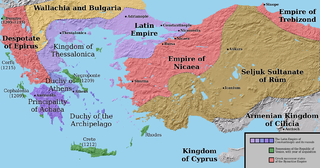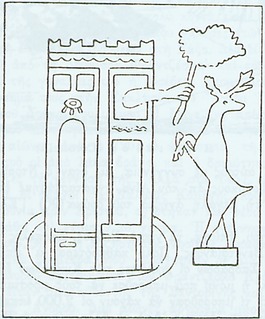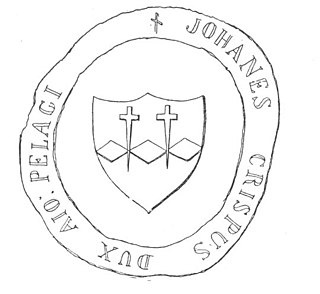Related Research Articles

Andros is the northernmost island of the Greek Cyclades archipelago, about 10 km (6 mi) southeast of Euboea, and about 3 km (2 mi) north of Tinos. It is nearly 40 km (25 mi) long, and its greatest breadth is 16 km (10 mi). It is for the most part mountainous, with many fruitful and well-watered valleys. The municipality, which includes the island Andros and several small, uninhabited islands, has an area of 380 km2 (146.719 sq mi). The largest towns are Andros (town), Gavrio, Batsi, and Ormos Korthiou.

The Duchy of the Archipelago, also known as Duchy of Naxos or Duchy of the Aegean, was a maritime state created by Venetian interests in the Cyclades archipelago in the Aegean Sea, in the aftermath of the Fourth Crusade, centered on the islands of Naxos and Paros. It included all the Cyclades. In 1537 it became a tributary of the Ottoman Empire, and was annexed by the Ottomans in 1579; however, Christian rule survived in islands such as Siphnos and Tinos.
Angelo Sanudo was the second Duke of the Archipelago from 1227, when his father, Marco I, died, until his own death.
Marco II Sanudo was the third Duke of the Archipelago from 1262 to his death.
Nicholas I Sanudo was the fifth Duke of the Archipelago from 1323 to his death. He was the son and successor of William I of the House of Sanudo.
Florence Sanudo or Fiorenza, was Duchess of the Archipelago in 1362–1371, in co-regency with her second spouse.

The Frankokratia, also known as Latinokratia and, for the Venetian domains, Venetokratia or Enetokratia, was the period in Greek history after the Fourth Crusade (1204), when a number of primarily French and Italian states were established by the Partitio terrarum imperii Romaniae on the territory of the dissolved Byzantine Empire.
Nicholas II Sanudo was the Lord of Gridia and eighth Duke of the Archipelago as the consort of his cousin Florence Sanudo, with whom he reigned until her death.

Nicholas III dalle Carceri, ninth Duke of the Archipelago and Lord of Euboea, was the only son of the first marriage of eighth Duchess Florence Sanudo, whom he succeeded in 1371, to Giovanni dalle Carceri, Lord of Euboea.
Maria Sanudo was lady of the island of Andros in the Duchy of the Archipelago in 1372-1383, and lady of the island of Paros and of one third of Negroponte in 1383-1426 in co-regency with her spouse, Gaspare Sommaripa.
Guglielmazzo Sanudo, fl. between 1349 and 1362, was a Lord of Gridia.
Giacomo I Crispo (1383–1418) was the eleventh Duke of the Archipelago, etc., from 1397 to 1418, son of the tenth Duke Francesco I Crispo and wife Fiorenza I Sanudo, Lady of Milos, and brother of John II and William II.
Gaspare Sommaripa was a Lord of Paros by right of his wife.
Gian Giacomo Crispo (1446–1453) was the fourteenth Duke of the Archipelago, etc., from 1447 to 1453, son of the thirteenth Duke Giacomo II Crispo and Ginevra Gattilusio.
Pietro Zeno, was lord of Andros from 1384 until his death in 1427, and a distinguished diplomat in the service of the Republic of Venice.
Marino Dandolo was a Venetian nobleman and first Latin ruler of the island of Andros following the Fourth Crusade. He was a member of the prominent Dandolo family. He accompanied Marco Sanudo on the conquest of the Aegean Islands in 1207, and was awarded the island of Andros as a sub-fief. He was expelled from his island around 1239 by Geremia Ghisi, and died in exile before August 1243.
Paros is an island of the Cyclades group in the central Aegean Sea, which in 1389 became a separate lordship within the Duchy of the Archipelago that lasted until the Duchy's conquest by the Ottoman Empire in 1537.
Giovanni Sommaripa was the lord of Andros island from 1466 until his death in battle against the Ottomans in 1468. He was a son of Domenico Sommaripa. He was succeeded by his brother, Crusino II Sommaripa.

John IV Crispo or Giovanni IV (1500-1564), was the sovereign Duke of the Archipelago, ruling from 1517, when he succeeded Francesco III Crispo. He was succeeded in 1564 by the last Duke, Giacomo IV Crispo.
Geremia Ghisi was a Venetian nobleman who in ca. 1207, following the Fourth Crusade, captured the Greek islands of Skiathos, Skopelos, and Skyros and became their lord, while his brother Andrea Ghisi conquered the islands of Tinos and Mykonos. Their sister or half-sister, Agnese Ghisi, married Othon de Cicon, who became the lord of Karystos on Euboea.
References
- ↑ Miller 1921, pp. 169–170.
- ↑ Miller 1908, p. 592.
- ↑ Miller 1908, pp. 593–595.
- ↑ Miller 1908, p. 459.
- ↑ Miller 1908, pp. 423, 605.
- ↑ Setton 1978, pp. 92–93.
- ↑ Miller 1908, pp. 595, 604–605.
- ↑ Setton 1978, p. 93 (note 47).
- ↑ Miller 1908, p. 605.